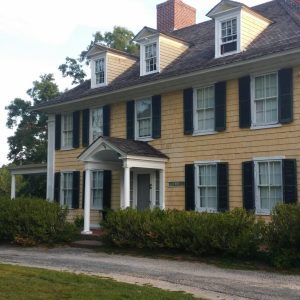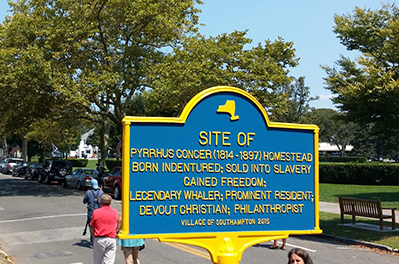Recently, Joseph McGill, the founder of the Slave Dwelling Project, spoke at an online event co-hosted by the Afro-American Historical and Genealogical Society, Jean Sampson Scott Greater New York Chapter and the NYG&B.
Watch the Presentation
Joseph McGill's presentation (followed by a Q&A) was recorded and is available for all to watch on YouTube.
He discussed the project, its origins, and the dwellings that he has slept in along the way. This article provides some notable highlights from his presentation.
The origins of the Slave Dwelling Project
According to Mr. McGill, the idea of the Slave Dwelling Project began at the Magnolia Plantation & Gardens in Charleston, South Carolina. This plantation was established by the Draytons in 1676 where the family owned enslaved people who slept in cabins nearby.
One day, Mr. McGill decided to sleep in one of the cabins overnight. Dwelling where African Americans lived while they were in bondage sparked many thoughts and feelings for him.

As an African American man who grew up and went to school in South Carolina, he was exposed to a revisionist interpretation of history that suggested slavery only existed in plantations. He believed that he was taught to put “slavery in a box.” That did not become more apparent than that night at Magnolia.
In trying to catch some sleep, Mr. McGill could not help but think of all of the children that were born in these cabins. The children born there were people, yet at the time of their birth they were deemed chattel by those that owned them and exploited their labor. That thought stuck with Mr. McGill.
Yards away from the cabin Mr. McGill stayed in was the Big House; a beautiful structure that was likely constructed by the enslaved African Americans who dwelled in the cabins. That massive, beautiful house serves as a symbol for slavery and much more. The people that constructed that building were not just mere laborers, as Mr. McGill noted.
The African Americans that built that house had valuable skills. Their hands are the ones that created the bricks for the house that would symbolize an era of economic prosperity for the South.
His mission then became to change the narrative of where enslaved people lived. Slavery existed beyond the plantation just like an enslaved person’s valuable skills could be applied beyond the plantation.
Slave Dwellings in New York State
So where else did enslaved people dwell? That is the question that fuels the Slave Dwelling Project.
In 2015, Mr. McGill got to ask that very question in New York. His answer led him to Long Island. We encourage everyone to read his two articles, Slavery in New York and Slavery in New York Part II on the Slave Dwelling Project website.
Sylvester Manor

There, he visited Sylvester Manor, which was owned by the grandson of Nathaniel Sylvester who owned two plantations and over 200 slaves in Barbados.
African slaves and indentured servants built the manor.
Mr. McGill got to sleep in space those people lived in and he immediately realized how hard the space was to navigate and how difficult it must have been for so many people to live in one space.
Also, he imagined the horror some may have experienced carrying hot food to the owners of the plantation.
One mistake in a cramped staircase meant that a cruel punishment was going to be inflicted on an enslaved person. That thought is unsettling.
Unlike the Sylvester Manor, the Joseph Lloyd Manor in Suffolk County had Mr. McGill encounter a very different story.
Joseph Lloyd Manor
Jupiter Hammon, a slave who eventually became the first black poet to be published in America, lived on the grounds of the manor. When Mr. McGill slept where Hammon slept, he was amazed by Hammon’s room. He noted that the room was on the second floor and it had two windows and a fireplace.
This observation made Mr. McGill deduce that because of Jupiter Hammon’s “less stressful living condition,” he had the time and energy to be a writer, which is a skill that takes a great deal of time to develop.
The home of Pyrrhus Concer
Another interesting story that Mr. McGill encountered and wanted to preserve is that of Pyrrhus Concer. This time around, there was no dwelling for him to sleep in.

Concer homestead.
The home of Pyrrhus Concer was demolished and through the Slave Dwelling Project, Mr. McGill and others advocate for the reconstruction of Concer's house on the site where it once stood.
This home is important because Pyrrhus Concer was born enslaved and was later freed, which gave him the opportunity to go on whaling expeditions.
During one of those expeditions, he rescued Japanese sailors. He was the first American to see Tokugawa era Japan during the period when sakoku (closed country) remained in place. Rebuilding his home would give Concer's community the chance to tell his great American story.
As one can see, Mr. McGill’s trip to New York encapsulates what the Slave Dwelling Project is working towards. It seeks to show people what Mr. McGill long realized when sleeping where slaves once lived: slavery did not exist in a box. Mr. McGill wanted to find out more about how enslaved people lived and how their experiences varied in order to give them their agency in history.
Support the Slave Dwelling Project
The purpose of the Slave Dwelling Project is to document and preserve slave dwellings across the country while mitigating the demolition of these dwellings.
The project seeks to help property owners, government agencies and organizations with these important tasks. Preserving these dwellings gives historians a platform to teach the general public about slavery from a different perspective, which is one that restores the agency of the enslaved African Americans whose voices were left out of documents.
During Mr. McGill’s journey, he has visited slave dwellings across 25 states. In trying to learn, educate, and preserve, Mr. McGill and his team have slept in slave dwellings to change the narrative around slavery. Due to their work, others on the ground can contribute to their communities and preserving black histories that are often erased.
People can get involved by supporting and donating to the Slave Dwelling Project. Doing so helps them challenge many people’s “Gone with the Wind” interpretation of history that does our history and its agents harm. Thankfully, with one slave dwelling at a time, Mr. McGill and company are deconstructing the public’s ideas and thoughts on slavery brick by brick until people can stop seeing the Big House and see the people on the ground who made them instead.
